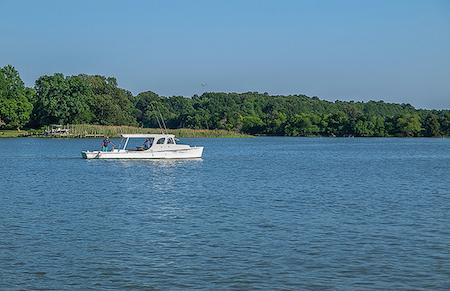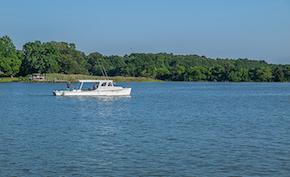The oyster restoration war of words continues. After grudgingly agreeing last week to finish some federally funded reef construction in the Tred Avon River, Maryland watermen gave a hostile reception Tuesday night to plans to create even more bivalve habitat there that would be off-limits to commercial harvest.

Plans to do more oyster reef construction in the Tred Avon River are getting pushback from watermen.
At a public meeting in Easton, federal and state officials were peppered with skeptical questions about a proposal to build up to 57 acres of new reefs in the Tred Avon, a tributary of the Choptank River, and plant millions of hatchery-spawned oysters on them, as well as on 71 acres of existing natural reefs.
The queries were submitted anonymously in writing, but it was clear they came from grumbling watermen in the audience. Their leaders stood at the end of the two-hour session to denounce the oyster restoration effort in Maryland’s portion of the Chesapeake Bay. They claimed it has been a costly failure, despite two recent reports that oysters planted on restored reefs over the past few years appear to be doing well.
“Preliminary reports show it’s not successful,” insisted Bunky Chance, president of the Talbot Waterman Association. “You have not reached your goals.”
The meeting showed that the long-running debate in Maryland over how to revive the Bay’s depleted oyster population is far from over. Maryland watermen are pressing to reopen at least some of the sanctuaries the state created six years ago, including the Tred Avon. And they chafe at the massive public investment in restoration, seeking more of it for their industry.
In 2010, the state put 24 percent of its Bay bottom off limits to harvest, hoping that by leaving the remaining oysters alone they would live longer, spawn and develop natural resistance to diseases that have periodically devastated the reefs. Maryland further pledged, along with Virginia, to conduct large-scale restoration efforts in five Bay tributaries in each state. The Tred Avon is one of three rivers Maryland has targeted so far for such work.
The U.S. Army Corps of Engineers, which is underwriting and handling the Tred Avon project, has already constructed 16 acres of reefs in the river. Last week, after much debate, Maryland’s Oyster Advisory Commission, with seafood interests heavily represented, reluctantly endorsed building another eight acres. The Corps is looking to complete the overall plan for restoring oysters on a total of 146 acres in the Tred Avon by creating more reefs in shallower water — less than nine feet deep. With $1.4 million spent already, the overall project is estimated to cost $11.4 million.
Watermen challenged the plan, saying the sanctuaries have cost their industry and don’t appear to be bringing oysters back. They contend that a similar restoration project in Harris Creek, another Choptank tributary, has failed to yield higher oyster reproduction than occurs naturally in nearby Broad Creek, where bivalves are regularly harvested by watermen. About 350 acres of reefs were built in Harris Creek, and seeded with 2 billion hatchery oysters there. The $26 million cost was paid for by state and federal funds.
Angie Sowers, a Corps biologist overseeing the Tred Avon project, pointed out that a recent report on oysters planted in Harris Creek three years ago found they were thriving. All the reefs checked had at least the minimum hoped-for density of bivalves, she said, and half had 50 or more per square meter, the goal scientists had set for the effort. Though it will likely take another five years to say for sure if the restoration has been a success, she said, all early indications are good.
A report last week by the state Department of Natural Resources also found that oysters are generally surviving well in Maryland’s expanded network of sanctuaries, including Harris Creek. “Biomass in the sanctuaries is increasing,” Sowers observed, while noting that the wild oyster harvest has also increased since the sanctuary expansion.
Watermen at the meeting remained unconvinced. Many contend that oysters left unharvested will spread disease and die — though the DNR report found disease rates low in the sanctuaries and public waters alike. “If it’s sustainable, let it alone and see how long it’s going to last,” Robert Newberry, head of the Delmarva Fisheries Association, said of Harris Creek. “I’m telling you, it’s not going to last.”
Robert T. Brown Sr., president of the Maryland Watermen’s Association, argued that all restoration work should be put on hold until problems with reef construction in Harris Creek are corrected. Some of the oyster habitat built there exceeded the prescribed height, rising so high in the water that some boats have struck them and been damaged.
Sowers said the Corps is working to fix the reefs and blamed the situation on mistakes made by the contractor hired for the work. She noted that federal officials have consulted with watermen to adjust the Tred Avon restoration plan to address some of their concerns, and she vowed to search for more oyster shell with which to build reefs there. Watermen have complained about the use of other materials, particularly granite rocks, which they blame for damaging vessels and fishing gear in Harris Creek.
Chris Judy, shellfish program leader for Maryland’s DNR, also vowed to heed watermen’s concerns. “We don’t want to have the same kind of problems we’ve seen in the past,” he said. He explained that state officials would keep tabs on the work to see that reef construction doesn’t create any more navigation problems.
While some written comments submitted anonymously at the meeting voiced support for the restoration, only Matt Pluta, the Choptank Riverkeeper, stood up to speak openly in favor. “Short-term economic gains should not overshadow long-term ecological benefits, which we are trying to achieve here,” he said.
The Corps is taking public comments on the Tred Avon restoration plan through Aug. 19. It expects to issue a final supplemental environmental assessment on the project in September. To read the draft assessment, go to www.nab.usace.army.mil/Missions/Environmental/Oyster-Restoration. Written comments can be sent via email to [email protected] or via mail to: U.S. Army Corps of Engineers, Baltimore District, Attn: Angie Sowers, 10 South Howard Street, Suite 11600 Baltimore, MD 21201.
By Timothy B. Wheeler, Bay Journal News Service
Timothy B. Wheeler is managing editor and project writer for the Bay Journal. He has more than two decades of experience covering the environment for The Baltimore Sun and other media outlets.



Michael Johnson says
John Griffin killed any hope of a joint effort supported by both waterman and environmental concerns. He was deceitful and malicious towards waterman and that is a shame because they have a wealth knowledge to draw from. State officials like to think they can evaluate a situation better with one day’s observation a month than waterman looking the situation every day and it just isn’t so.